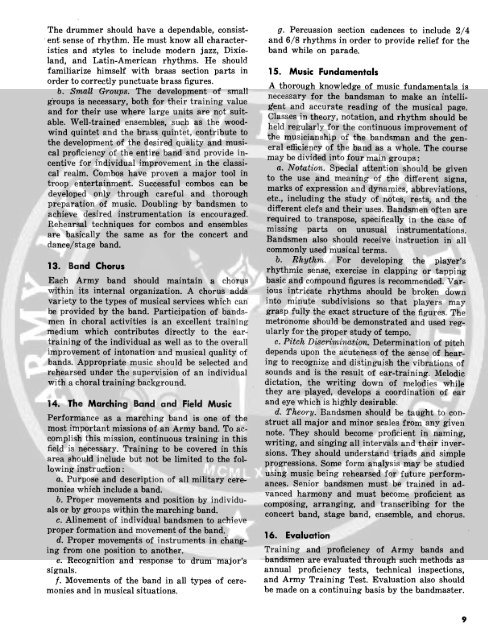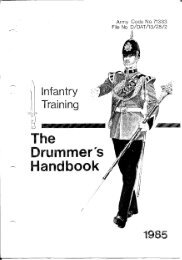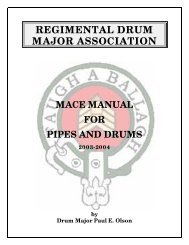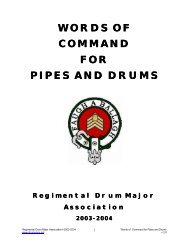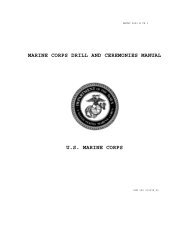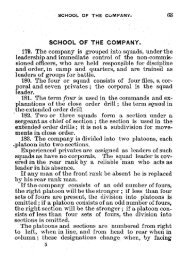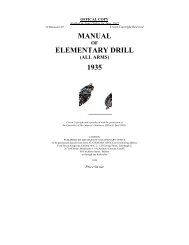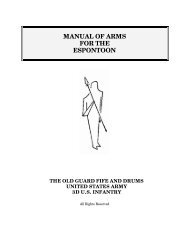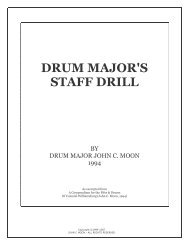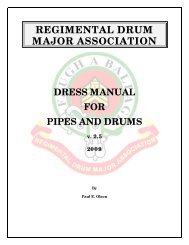The Military Band - Regimental Drum Major Association
The Military Band - Regimental Drum Major Association
The Military Band - Regimental Drum Major Association
Create successful ePaper yourself
Turn your PDF publications into a flip-book with our unique Google optimized e-Paper software.
<strong>The</strong> drummer should have a dependable, consist- g. Percussion section cadences to include 2/4<br />
ent sense of rhythm. He must know all characteristics<br />
and styles to include modern jazz, Dixieland,<br />
and Latin-American rhythms. He should<br />
and 6/8 rhythms in order to provide relief for the<br />
band while on parade.<br />
familiarize himself with brass section parts in<br />
order to correctly punctuate brass figures.<br />
te<br />
b. Small Groups. <strong>The</strong> development of small<br />
groups is necessary, both for their training value<br />
and for their use where large units are not suitable.<br />
Well-trained ensembles, such as the wood-<br />
15. Music Fundamentals<br />
A thorough knowledge of music fundamentals is<br />
necessary for the bandsman to make an intelli-<br />
ent and accurate reading of t musical page.<br />
Classes in theory, notation, and rhythm should be<br />
wind quintet and the brass quintet, contribute to<br />
the development of the desired quality and musi-<br />
cal proficiency of the entire band and provide incentive<br />
for individual improvement<br />
cal realm..<br />
in the classi-<br />
Combos hava.<br />
cal realm. Combos have proven a major tool in<br />
troop entertainment. Successful combos can be<br />
developed only through careful and thorough<br />
preparation of music. Doubling by bandsmen to<br />
Rehearsal techniques for combos and ensembles<br />
are basically the same as for the concert and<br />
dance/stage band.<br />
the he musicianship of the bandsman and the general<br />
efficiency of the band as a whole. <strong>The</strong> course<br />
may be divided into four main groups:<br />
Notation. Special attention should be given<br />
to the use and meaning of the different signs,<br />
marks of expression and dynamics, abbreviations,<br />
etc., including the study of notes, rests, and the<br />
re different ation clefs and their uses. <strong>Band</strong>smen often are<br />
required to transpose, specifically in the case of<br />
missing parts on unusual instrumentations.<br />
<strong>Band</strong>smen also should receive instruction in all<br />
commonly used musical terms.<br />
13. <strong>Band</strong> Chorus<br />
b. Rhythm. For developing the player's<br />
rhythmic sense, exercise in clapping or tapping<br />
Each Army band should maintain a chorus basic and compound figures is recommended. Varwithin<br />
its internal organization. A chorus adds<br />
variety to the types of musical services which can<br />
ious intricate rhythms should be broken down<br />
into minute subdivisions so that players may<br />
be provided by the band. Participation of bandsmen<br />
in choral activities is an excellent training<br />
medium which contributes directly to the eartraining<br />
of the individual as well as to the overall<br />
grasp fully the exact structure of the figures. <strong>The</strong><br />
metronome should be demonstrated and used reg-<br />
ularly for the proper study of tempo.<br />
c. Pitch Discrimination.. Determination of pitch<br />
improvement of intonation and musical quality of<br />
bands. Appropriate music should be selected and<br />
rehearsed under the supervision of an individual<br />
with a choral training background.<br />
depends upon the acuteness of the sense of hear-<br />
ing to recognize and distinguish the vibrations of<br />
sounds and is the result of ear-training. Melodic<br />
dictation, the writing down of melodies while<br />
they are played, develops a coordination of ear<br />
14. <strong>The</strong> Marching <strong>Band</strong> and Field Music<br />
Performance Performance<br />
as a marching band is one of the<br />
most important missions of an Army band. To acand<br />
eye which is highly desirable.<br />
d. <strong>The</strong>ory. <strong>Band</strong>smen should be taught to construct<br />
all major and minor scales from any given<br />
note. <strong>The</strong>y should become proficient in naming,<br />
complish this mission, continuous training in this<br />
field is necessary. Training to be covered in this<br />
writing, and singing all intervals and their inver-<br />
sions <strong>The</strong>y should understand triads and simple<br />
area should include but not be limited to the fola.lowing<br />
instruction: descriptionofallmilitaryce<br />
a. Purpose and description of all military cereprogressions.<br />
Some form analysis may be studied<br />
progressions. Some form analysis may be studied<br />
using music being rehearsed for future perform-<br />
ances. Senior bandsmen must be trained in admonies<br />
include which a band.<br />
b. Proper movements and position by individuc.<br />
Alinement of individual bandsmen to achieve<br />
proper formation and movement of the band.<br />
d. Proper movements of instruments in chang-<br />
vanced harmony and must become proficient as<br />
composing, aranging, and transcribing for the<br />
composing, arranging, and transcribing for the<br />
concert band, stage band, ensemble, and chorus.<br />
ing from one position to another.<br />
e. Recognition and response to drum major's<br />
Training and proficiency of Army bands and<br />
bandsmen are evaluated through such methods as<br />
signals. annual proficiency tests, technical inspections,<br />
f. Movements of the band in all types of cere- and Army Training Test. Evaluation also should<br />
monies and in musical situations. be made on a continuing basis by the bandmaster.<br />
9


